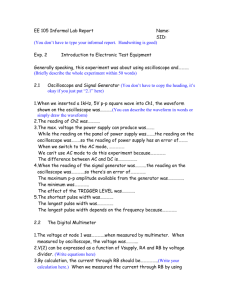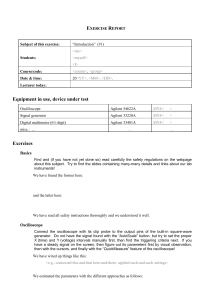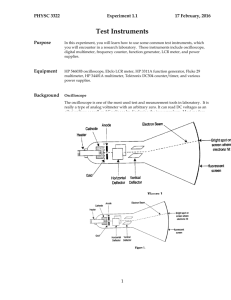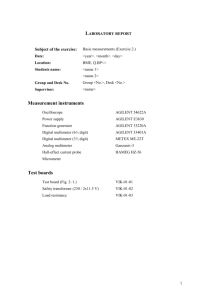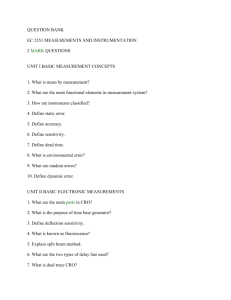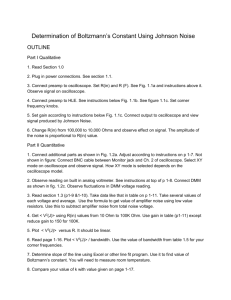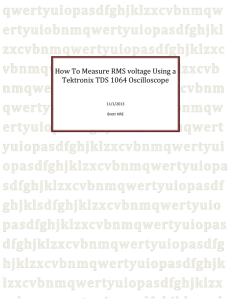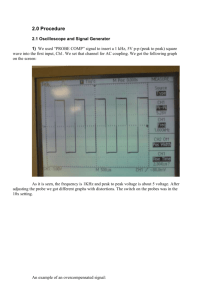Lab_01_v2011 - Nuclear Physics Group
advertisement
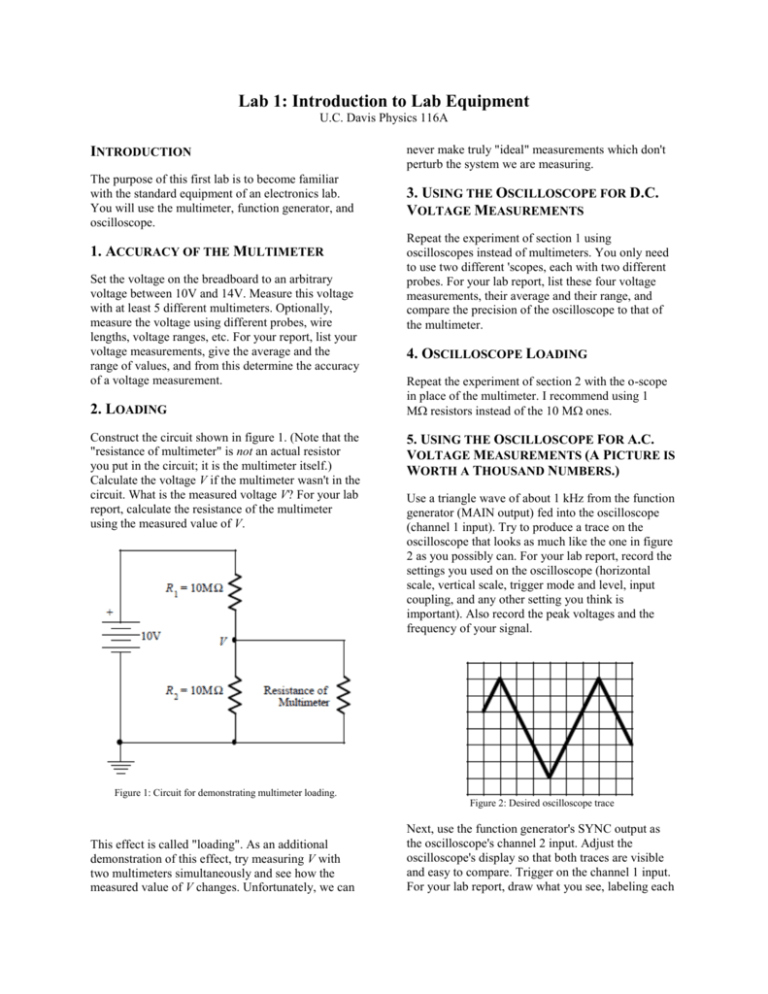
Lab 1: Introduction to Lab Equipment U.C. Davis Physics 116A INTRODUCTION never make truly "ideal" measurements which don't perturb the system we are measuring. The purpose of this first lab is to become familiar with the standard equipment of an electronics lab. You will use the multimeter, function generator, and oscilloscope. 3. USING THE OSCILLOSCOPE FOR D.C. VOLTAGE MEASUREMENTS 1. ACCURACY OF THE MULTIMETER Set the voltage on the breadboard to an arbitrary voltage between 10V and 14V. Measure this voltage with at least 5 different multimeters. Optionally, measure the voltage using different probes, wire lengths, voltage ranges, etc. For your report, list your voltage measurements, give the average and the range of values, and from this determine the accuracy of a voltage measurement. 2. LOADING Construct the circuit shown in figure 1. (Note that the "resistance of multimeter" is not an actual resistor you put in the circuit; it is the multimeter itself.) Calculate the voltage V if the multimeter wasn't in the circuit. What is the measured voltage V? For your lab report, calculate the resistance of the multimeter using the measured value of V. Repeat the experiment of section 1 using oscilloscopes instead of multimeters. You only need to use two different 'scopes, each with two different probes. For your lab report, list these four voltage measurements, their average and their range, and compare the precision of the oscilloscope to that of the multimeter. 4. OSCILLOSCOPE LOADING Repeat the experiment of section 2 with the o-scope in place of the multimeter. I recommend using 1 Mresistors instead of the 10 M ones. 5. USING THE OSCILLOSCOPE FOR A.C. VOLTAGE MEASUREMENTS (A PICTURE IS WORTH A THOUSAND NUMBERS.) Use a triangle wave of about 1 kHz from the function generator (MAIN output) fed into the oscilloscope (channel 1 input). Try to produce a trace on the oscilloscope that looks as much like the one in figure 2 as you possibly can. For your lab report, record the settings you used on the oscilloscope (horizontal scale, vertical scale, trigger mode and level, input coupling, and any other setting you think is important). Also record the peak voltages and the frequency of your signal. Figure 1: Circuit for demonstrating multimeter loading. Figure 2: Desired oscilloscope trace This effect is called "loading". As an additional demonstration of this effect, try measuring V with two multimeters simultaneously and see how the measured value of V changes. Unfortunately, we can Next, use the function generator's SYNC output as the oscilloscope's channel 2 input. Adjust the oscilloscope's display so that both traces are visible and easy to compare. Trigger on the channel 1 input. For your lab report, draw what you see, labeling each trace appropriately (e.g., peak voltages, voltage and time scales, times of intersects, etc.). Note in particular the phase relationship between the two signals. Next, replace the channel 2 input with the MAIN output of a different function generator. Try to adjust the function generators so that both traces "hold still". For your lab report, explain what is different about using two function generators' outputs vs. using two outputs from the same function generator. 6. MEASURING [AC] SINE WAVES Consider a general formula for a sine wave: v(t) V0 v0 cos2ft . Use the function generator to generate a sine wave with V0 5V, v0 3V, and f 7 kHz. For your lab report, give the name of each of these parameters and which function generator knob controls them. Observe this waveform on the 'scope with the input coupling set to "DC". Measure the three parameters set above. Now change the input coupling to "AC" and repeat the measurements. For your lab report, describe what has changed and decide whether DC or AC coupling is better for general purpose use. Measure the same sine wave using the multimeter. Try both the DC voltage and AC voltage settings. Does the DC setting give V0? Is the reading steady? Does the AC setting give v0? Does it give v0 / 2 ? This is the "RMS" voltage. Is the reading steady? For your lab report, answer these questions. 7. OSCILLOSCOPE TEST Have a friend (or me) quiz you on the use of the oscilloscope. Test giver: hide the function generator from the test taker's view and set some random frequency, amplitude, and DC offset. Test taker: shut off the 'scope then turn it back on (to reset it) and try your best to measure the secret signal's frequency, amplitude, and DC offset. For your lab report, give your percent accuracy using the o-scope. 8. SUMMARY OF THE OSCILLOSCOPE For your lab report, use your own words to describe what the following oscilloscope settings do: • • horizontal scale vertical scale • • • • trigger mode trigger source trigger level input coupling (DC vs. AC)
